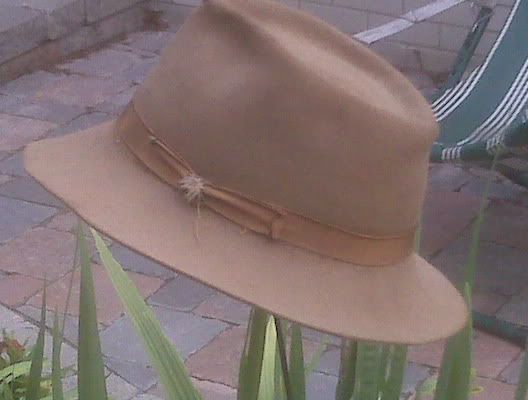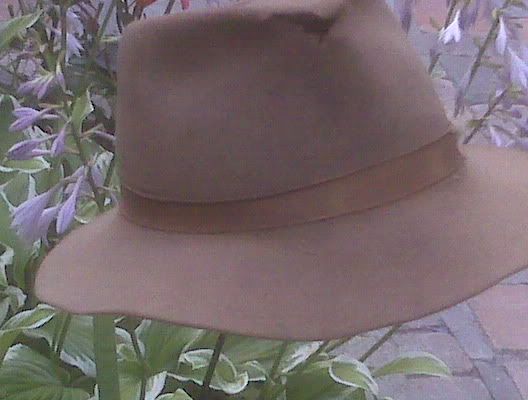I'd posted this elsewhere, but here's an article on Biltmore from the Toronto Star in October '09.
From the Roaring Twenties to a current urban market, hat company maintains popularity
Oct 02, 2009 04:30 AM
Nicole Baute
Living reporter
Guelph–Now, this is retro.
Antique Singer sewing machines whirl, flanked by rows of wooden hand flanges and drawers of ribbons with romantic names like silver belly, cognac and bordeaux. Although the Guelph hat factory feels almost empty, there are still 12 hatters here making Biltmores, a legendary brand dating back to 1917. Black straw and fur felt fedoras in burgundy, grey and rust fill wooden racks, en route to New York and New Orleans.
Eric Lynes, a dapper man from Louisville, Ky., looks like a character from a bygone era in his black dress shirt and pecan "diamond crown" with its small, stylish brim. Since buying the company in 2005 and pulling it out of receivership, he has become, quite literally, the new face of the Biltmore Hat Co.
"You know, when I first took over a lot of the critics were like, `Why today, when most of the industry is turning to China?'" he says. "And I'm like, well, I started this venture looking for a quality manufacturer so we're gonna keep it that way."
The well-heeled recognize the handcrafted quality of a Biltmore, which retails for $150 to $225. Biltmore has taken special orders for celebrities like Shaquille O'Neal and Alicia Keys, who ordered a fuzzy white fur felt hat. A flash of the company crest appeared in The Good Shepherd, the 2006 spy movie starring Matt Damon.
These days, the hippest hat is the stingy (or small) brim fedora, as worn by Brad Pitt, Justin Timberlake and the cast of the hit TV series Mad Men.
Lynes did not start out as a hat connoisseur. But he always liked hats, even loved them. It was his search for quality that led the Toyota employee-turned-entrepreneur to Biltmore Hats, a Canadian company that has managed to survive for more than 90 years, despite changes in men's fashion and company ownership – and two bankruptcies.
In the company's heyday, 300 or 400 employees cranked out more than a million hats a year. Now the staff of 20, 12 of them actual hatters, produce about 30,000 annually. And they just got out of the red, Lynes says.
From its beginnings marketing primarily to white, middle-class Canadian businessmen, many of them just coming home from World War I, Biltmore seems to have been given another reprieve from an urban, African-American market. Aside from the tan "peak" hats Biltmore makes for the RCMP and some hats sold in Canadian shops, the bulk of the company's clients are young black men, many of them under 40.
"That's what I discovered when I took over Biltmore, that most of the revenue was coming in from the African-American community," Lynes says. His retailers in New York, Chicago, New Orleans and Oakland, Calif., tell him that 75 per cent of their clients are black.
It doesn't hurt that the youthful-looking 52-year-old has become the brand's de facto model.
Lynes says his retailers insisted he model the hats for catalogue covers and posters, saying it would help them attract customers. A bit camera shy, Lynes eventually gave in, becoming the stylish new face of the company.
Biltmore began as the Fried Hat Co. in Niagara Falls in 1917. In 1919 it moved to Guelph and was purchased the following year by Frank Ramsay, Arthur W. Mean and Edward L. Macdonald.
To invoke glamour and prestige, the trio named their company after New York's Biltmore Hotel.
In 1947, Biltmore Hats began sponsoring a Junior A hockey team, the Guelph Biltmores. Eddie Shack played for the team in the 1950s and was known to sell discarded Biltmores to folks in his Sudbury hometown out of the back of used cars purchased for the occasion. (He would sell the cars, too.)
The company's product was "de rigueur" until the 1960s, says Dr. Alexandra Palmer, a textile and costume historian, and senior curator at the Royal Ontario Museum.
"It was a sign of professional man and the more expensive the hat, an urban hat opposed to a farmer's hat as just a means of shelter from the sun or elements, was an absolute requirement," she says. In the early 20th century, industrial cities and the professional middle class grew, and hats were ubiquitous.
John F. Kennedy's hatless inauguration on Jan. 20, 1961 is an often-cited cause of the decline of men's hats as a matter of social etiquette. But black men continued to wear them, Lynes says, propping up the industry.
Why? Perhaps because the hat is a status symbol, a self-esteem booster, Lynes speculates. "I would think that if you look at the community it's like (after) being pressed down in the past, from history, you always wanted to make a good impression," he says.
Biltmore hatter Kevin Giovanditto, 43, recalls the good old days as he finishes fastening leather bands on a rack of RCMP hats.
"There was a person at every single machine in this place," he says, wearing a baseball cap that says "Born to Ride."
"That's when hats were in, though. I mean, hats were really in ... That's when Indiana Jones was up, that movie Crocodile Dundee, we were doing thousands of them."
These days, young men in hats are probably trying to emulate celebrity style rather than channel the elegance of the Biltmore Hotel – or the escapades of Indiana Jones.
Lynes says the hat's popularity may have skipped a generation: today's young people see the hat as a trendy, nostalgic throwback and decide, at least he hopes, that "it's cool to wear a hat, because my pop didn't wear a hat."





